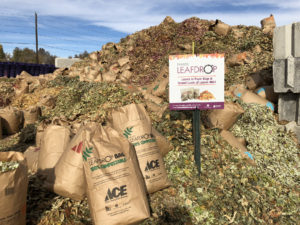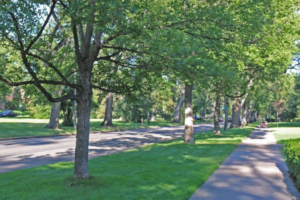 Try as we might to keep them well and reaching for the sky, sometimes we simply have no choice but to say goodbye to our strong, shady friends. Simply put, trees don’t live forever. And tree removal – while sad to see – is an expected part of the natural lifecycle. The “whys” of tree removal can vary greatly, but there are some rules that stand firm. One thing you’ll hear our foresters say often is “right tree, right place”. This simple reminder also serves as a starting point for the list of reasons a tree might need to be removed. Here are the top five reasons:
Try as we might to keep them well and reaching for the sky, sometimes we simply have no choice but to say goodbye to our strong, shady friends. Simply put, trees don’t live forever. And tree removal – while sad to see – is an expected part of the natural lifecycle. The “whys” of tree removal can vary greatly, but there are some rules that stand firm. One thing you’ll hear our foresters say often is “right tree, right place”. This simple reminder also serves as a starting point for the list of reasons a tree might need to be removed. Here are the top five reasons:
1. Right tree, wrong place.
This one breaks many hearts because, well, it didn’t have to end this way. Planting a good tree in a bad spot generally stems from a lack of understanding or planning on the part of the OP, or original planter. Reasons here can range from HOA regulations that don’t allow planting in certain areas, to some city regulations that don’t allow certain types of trees to be planted under overhead power lines or in certain rights-of-way. The best way to avoid this is to research in advance what’s allowed and where. For example, you should never plant a tree within 20 feet of a stop sign, 10 feet from a fire hydrant or five feet from water meters. And dial 8-1-1, it’s required prior to planting.
2. Wrong tree, right place.
Even if you have the perfect location for a tree that meets all the requirements outlined above, there are still some trees that aren’t permitted due to structural issues, overplanting or threats of invading insects. The most common trees planted without permits are silver maple, autumn blaze maple, aspen, cottonwood, evergreens and of course the ash tree, which we know is at the greatest risk for invasion by the emerald ash borer.
3. Wrong tree, wrong place.
This is when everything’s, well, wrong. A small spruce tree planted along the street near the corner may not be a concern now, but as the tree grows it’s likely to create a visibility obstruction for drivers and pedestrians. It may also shade the sidewalk and/or street, delaying the melting of snow and ice, which may create dangerous conditions for the public utilizing the public right-of-way. In this case, it’s best to remove the tree while it’s small and before it becomes a safety concern.
4. Diseased or dead.
Health and safety of a tree isn’t always apparent to the naked eye. What may look lush and lively at first glance, might turn out to be hollow or otherwise sick, leaving passers-by, property and neighboring trees at risk. Learn how to tell if your young tree is diseased, dead or just dormant. For larger trees it’s probably best to contact a certified arborist to do a health evaluation.
5. Someone didn’t tree-t ‘em right.…and you thought we didn’t have any tree puns left!
We already know it – prevention is the best medicine. Infestations may spread to neighboring trees so removal may be necessary to prevent an infestation from impacting adjacent trees. If you currently have the right tree in the right place, we can’t stress enough that you should do whatever you can to keep it well for a long healthy life. That includes regular pruning and care and working with a professional arborist when needed.
The primary job of Denver’s Office of the City Forester is to attempt to preserve every tree we can, while also following these rules. If you see us removing a tree, it’s generally for one of the above reasons. If you think a tree is being wrongly removed, let us know by contacting our office at 720-913-0651.
 2022 has been a hot one. But the good news is, autumn is nearly here and soon the air will be crisp, sweaters will take over for t-shirts and your trees’ leaves will start to turn. Which then means your trees’ leaves will also begin to fall.
2022 has been a hot one. But the good news is, autumn is nearly here and soon the air will be crisp, sweaters will take over for t-shirts and your trees’ leaves will start to turn. Which then means your trees’ leaves will also begin to fall. 
 Try as we might to keep them well and reaching for the sky, sometimes we simply have no choice but to say goodbye to our strong, shady friends. Simply put, trees don’t live forever. And tree removal – while sad to see – is an expected part of the natural lifecycle. The “whys” of tree removal can vary greatly, but there are some rules that stand firm. One thing you’ll hear our foresters say often is “right tree, right place”. This simple reminder also serves as a starting point for the list of reasons a tree might need to be removed. Here are the top five reasons:
Try as we might to keep them well and reaching for the sky, sometimes we simply have no choice but to say goodbye to our strong, shady friends. Simply put, trees don’t live forever. And tree removal – while sad to see – is an expected part of the natural lifecycle. The “whys” of tree removal can vary greatly, but there are some rules that stand firm. One thing you’ll hear our foresters say often is “right tree, right place”. This simple reminder also serves as a starting point for the list of reasons a tree might need to be removed. Here are the top five reasons:  Hey, we get it – it’s easy to think “the more the merrier” when it comes to trees. But planting any tree in the public right-of-way (areas between the curb and sidewalk or next to the street), isn’t always good for the future of our urban canopy.
Hey, we get it – it’s easy to think “the more the merrier” when it comes to trees. But planting any tree in the public right-of-way (areas between the curb and sidewalk or next to the street), isn’t always good for the future of our urban canopy.